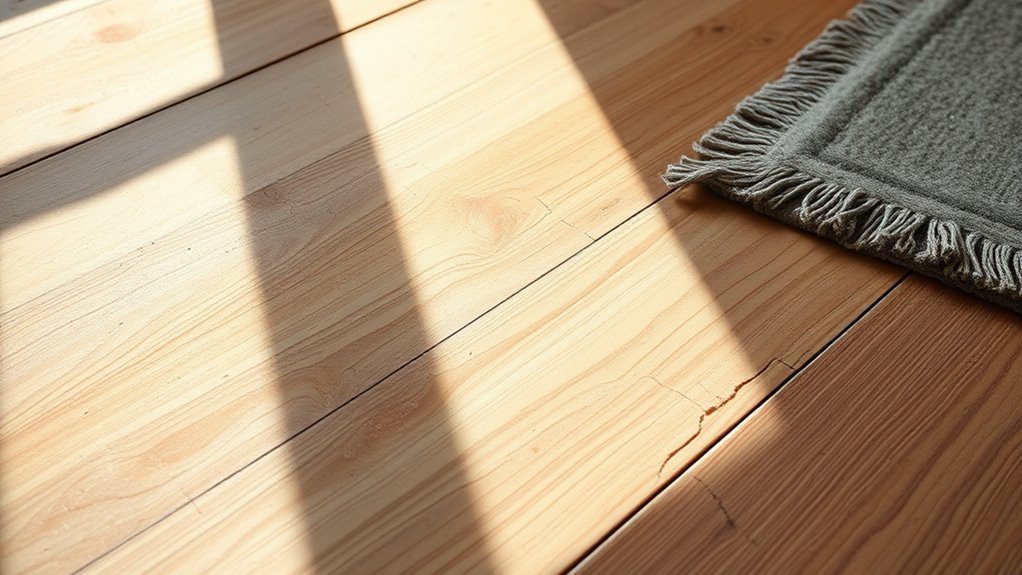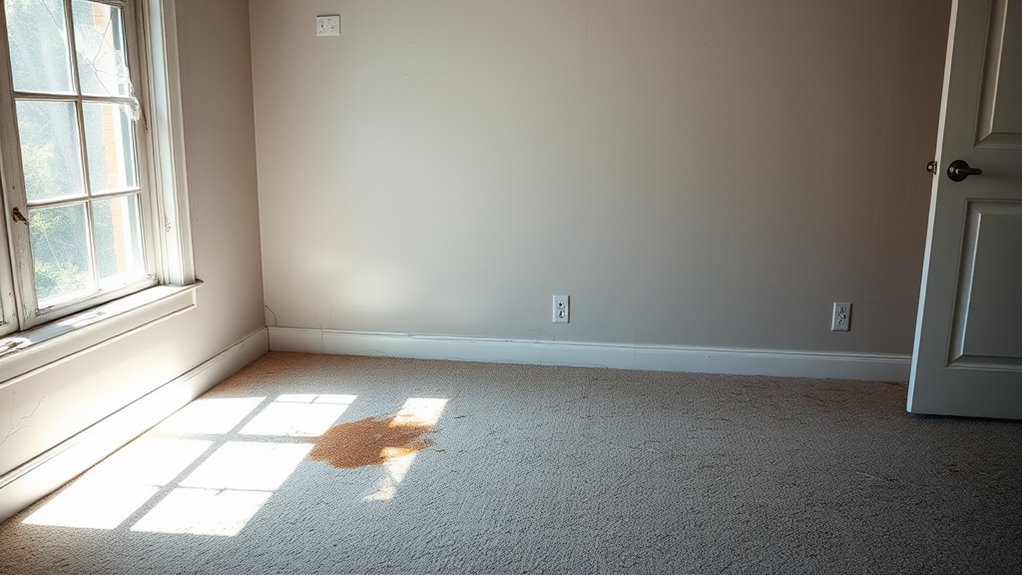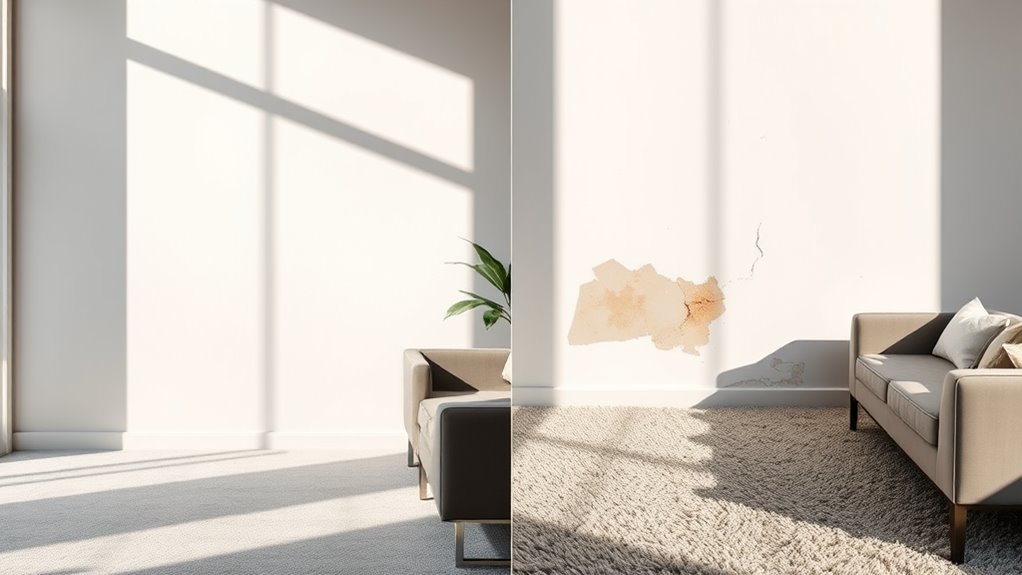Understanding the difference between rental property damage and normal wear and tear helps you avoid disputes. Normal wear includes faded paint or worn carpets, while damage results from negligence, like large wall holes or stained flooring. Document the property’s condition during move-in and move-out inspections to clarify responsibilities. Clear expectations and thorough records guarantee fair security deposit deductions. Discover how to handle these issues effectively for smoother tenant-landlord relationships.
Key Takeaways
- Normal wear and tear includes gradual deterioration like faded paint, while tenant damage involves negligence or misuse.
- Tenant damage may include large wall holes, carpet stains, or unauthorized alterations, leading to security deposit deductions.
- Move-in and move-out inspections with photos and checklists help distinguish damage from normal wear and tear.
- Security deposit deductions should be supported by clear evidence, such as timestamped photos and detailed documentation.
- Define normal wear and tear in the lease to set clear tenant expectations and minimize disputes over property conditions.
Understanding Normal Wear and Tear in Rental Properties
When renting a property, it’s important to understand that normal wear and tear is an inevitable part of everyday use. As a tenant, you’re not responsible for the gradual deterioration of the rental property caused by ordinary living. This includes minor issues like faded paint, worn carpets, or small nail holes, which are typically the landlord’s responsibility to address. However, normal wear and tear doesn’t cover damage resulting from negligence or misuse, which could lead to deductions from your security deposit. Your lease agreement should outline the landlord’s expectations, helping you distinguish between acceptable wear and excessive damage. Property management often conducts a move-out inspection to assess the condition of the rental property, so documenting its state at move-in can prevent disputes. Understanding these distinctions guarantees you’re prepared for a fair evaluation of your responsibilities as a tenant.
Common Examples of Tenant Property Damage
Tenant property damage encompasses several distinct issues that go beyond normal wear and tear. Large holes in walls from mounting heavy items or excessive force are considered damage, differing from small nail holes typical of normal use. Stains or burns on carpets or flooring caused by spills, accidents, or smoking fall under tenant negligence, not the natural fading expected over time. Unauthorized alterations, like repainting walls with non-approved colors or patterns, also qualify as damage, unlike minor scuffs from normal maintenance. Missing or broken window screens due to rough handling or neglect are tenant property damage, distinguishing them from dirt buildup, which is normal wear. Additionally, damage from misuse, such as broken appliances or fixtures, incurs repair costs for tenants, separate from routine upkeep managed by landlords. Utilizing tenant screening solutions can help identify potential tenants who may be more likely to cause property damage, reducing the risk of such issues. Identifying these issues helps clarify responsibilities and maintain property standards.
How to Differentiate Between Wear and Tear and Damage

Understanding the distinction between wear and tear and damage is essential for both landlords and tenants to manage property expectations effectively. Normal wear includes inevitable issues like small nail holes, faded paint, or lightly scratched surfaces due to everyday use. In contrast, tenant damage often results from negligence or carelessness, such as large holes, broken fixtures, or gouged flooring. Examples of normal wear, like peeling paint or faded carpets, differ greatly from considerable damage caused by unauthorized alterations or excessive wear. Landlords should meticulously document property conditions before and after tenancy to identify tenant damage accurately. This documentation is critical when determining whether to deduct repair costs from the security deposit. By recognizing these differences, you can guarantee fair assessments and avoid disputes over what constitutes normal wear versus property damage caused by negligence or misuse.
Importance of Move-In and Move-Out Inspections
Move-in and move-out inspections let you document the property’s condition, ensuring you’ve recorded all pre-existing issues before a tenant moves in. By comparing the property’s state at move-out to the initial documentation, you can accurately assess any tenant-caused damage. These inspections, supported by photos and detailed checklists, provide clear evidence to resolve disputes over security deposits.
Documenting Property Condition
Since disputes over property damage often arise at the end of a tenancy, documenting the property’s condition during move-in and move-out inspections is essential for safeguarding both landlords and tenants. Start by conducting thorough move-in inspections to record existing damages, such as minor scratches or faded paint, and include these details in the lease agreement. Use high-resolution photos or videos to capture every aspect of the property’s condition, providing clear evidence for future comparisons. Regular property inspections throughout the lease can help monitor changes and address issues early. At the end of the tenancy, perform detailed move-out inspections to identify tenant damage beyond normal wear and tear. This documentation guarantees fair security deposit deductions and minimizes disagreements over responsibility for repairs. Utilizing tools like the Long Term Rental Calculator can also help landlords assess financial impacts and plan for potential repairs or upgrades.
Assessing Tenant-Caused Damages
Accurately evaluating tenant-caused damages hinges on the effectiveness of move-in and move-out inspections. During the move-in inspection, document the property condition with photos and detailed notes to establish a baseline. This documentation helps differentiate between normal wear and tear and tenant-caused damage when conducting the move-out inspection. Use a checklist to systematically compare the property’s state to its initial condition, ensuring you address issues that exceed normal wear. Maintain clear records to support any decision to deduct from the security deposit for tenant damages. Regular inspections during the tenancy can also help identify problems early, minimizing costs. Thorough inspections and proper documentation not only protect your investment but also strengthen your position in disputes, complementing a robust tenant screening process for effective property management.
Best Practices for Handling Security Deposits

When handling security deposits, guarantee you document the property’s condition thoroughly with photos and detailed notes to support any deductions. Establish clear guidelines in the lease about what constitutes normal wear and tear versus damage to prevent disputes. Return the deposit promptly within the legal timeframe if no excessive damage is found.
Documenting Property Condition
Effective documentation of a property’s condition is essential for handling security deposits with transparency and fairness. Start by conducting a detailed move-in inspection, capturing photographic documentation of the property’s condition, including areas prone to normal wear and tear. Record existing damages in the lease agreement to prevent disputes during security deposit deductions. Use high-resolution, timestamped images to verify the property’s condition at both move-in and move-out stages. Maintain thorough records of inspections, noting any issues and repair costs to guarantee clarity with tenants. Update documentation throughout occupancy to distinguish between normal wear and tear and tenant-caused damage. Utilizing Google Analytics can help track website performance and visitor interactions related to rental property listings.
- Conduct a move-in inspection with photos and videos.
- Document existing damages in the lease.
- Use timestamped, high-resolution images.
- Keep detailed records of inspections and repairs.
- Update documentation regularly during occupancy.
Clear Deposit Guidelines
To guarantee transparency and fairness in handling security deposits, landlords should establish clear guidelines in the lease agreement that differentiate between normal wear and tear and tenant-caused damage. Clearly define what constitutes damage exceeding normal wear to set tenant expectations and minimize disputes. Collect a security deposit equivalent to one month’s rent to cover potential repairs. Provide tenants with a checklist detailing acceptable wear and tear to help them understand their responsibilities. Document the property’s condition thoroughly with photos and notes before and after occupancy to support any necessary deductions. Maintain transparency by returning the security deposit within the legally required timeframe and including an itemized list of deductions. Proper documentation and clear communication in the lease agreement ascertain both parties understand their obligations and rights. Engage a local title company to ensure proper documentation and compliance with regulations.
Timely Deposit Refunds
As landlords, you must return security deposits promptly, typically within 30 days after a tenant moves out, to comply with legal requirements and maintain trust. Conduct thorough move-in and move-out inspections to document the property’s condition, guaranteeing deductions are only made for damages beyond normal wear and tear. Include clear terms in the lease agreement to define what constitutes normal wear and tear versus damage, setting tenant expectations upfront. Under Texas law, you cannot withhold the security deposit for ordinary wear and tear, such as minor scuffs or faded paint. Provide an itemized list of any deductions made, supported by evidence like photos and inspection notes. Keep detailed records of all communications to guarantee transparency and protect against disputes. Use automated rent collection platforms like Baselane to streamline financial transactions and ensure timely deposit processing.
Preventive Measures to Minimize Property Damage
While property damage can be costly for landlords, preventive measures can greatly reduce its occurrence. Start by implementing thorough tenant screenings to identify responsible renters less likely to cause property damage. Conduct regular property inspections, ideally every six months, to catch potential issues early and address them before they escalate. Before tenants move in, document the property’s condition with high-quality photos and videos to establish a clear reference point. Include detailed clauses in the lease agreement that define the difference between normal wear and tear and property damage to set clear expectations and aid in conflict resolution. Provide tenants with maintenance guidelines to encourage proper care and minimize unnecessary damage. Consider using tenant management systems to streamline inspections and communication, further enhancing efficiency. These proactive steps not only protect your property but also guarantee a smoother process for handling security deposits and other disputes.
Conclusion
So, you’re wondering how to tell if that hole in the wall is “normal wear and tear” or “irresponsible tenant behavior”? Congratulations—now you know the difference. Of course, it’s not like your deposit will magically reappear if the landlord disagrees. Remember, inspections are your best friend, but only if you’re meticulous enough to document everything. After all, isn’t it ironic how easy it is to lose money over something so avoidable?




